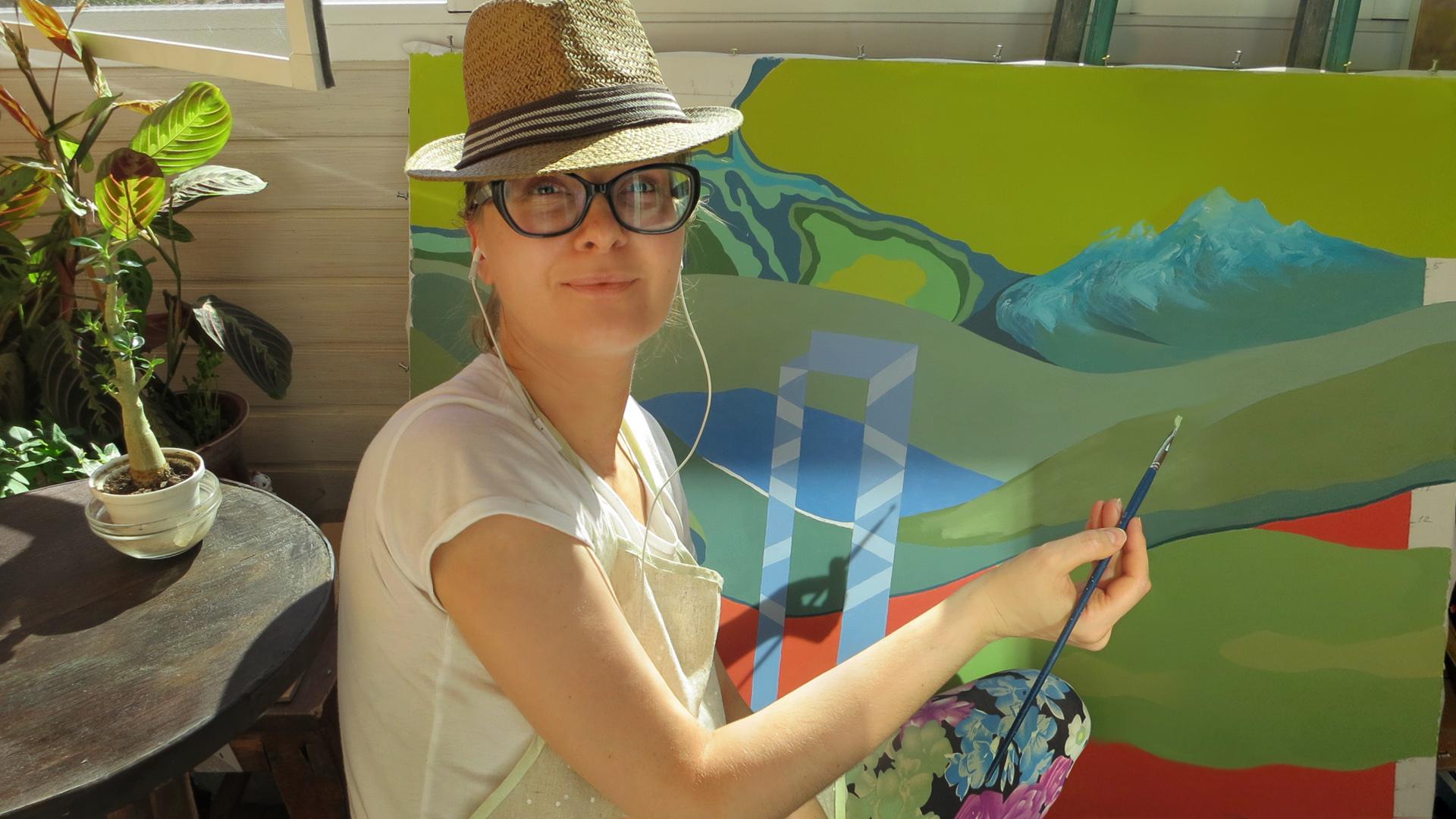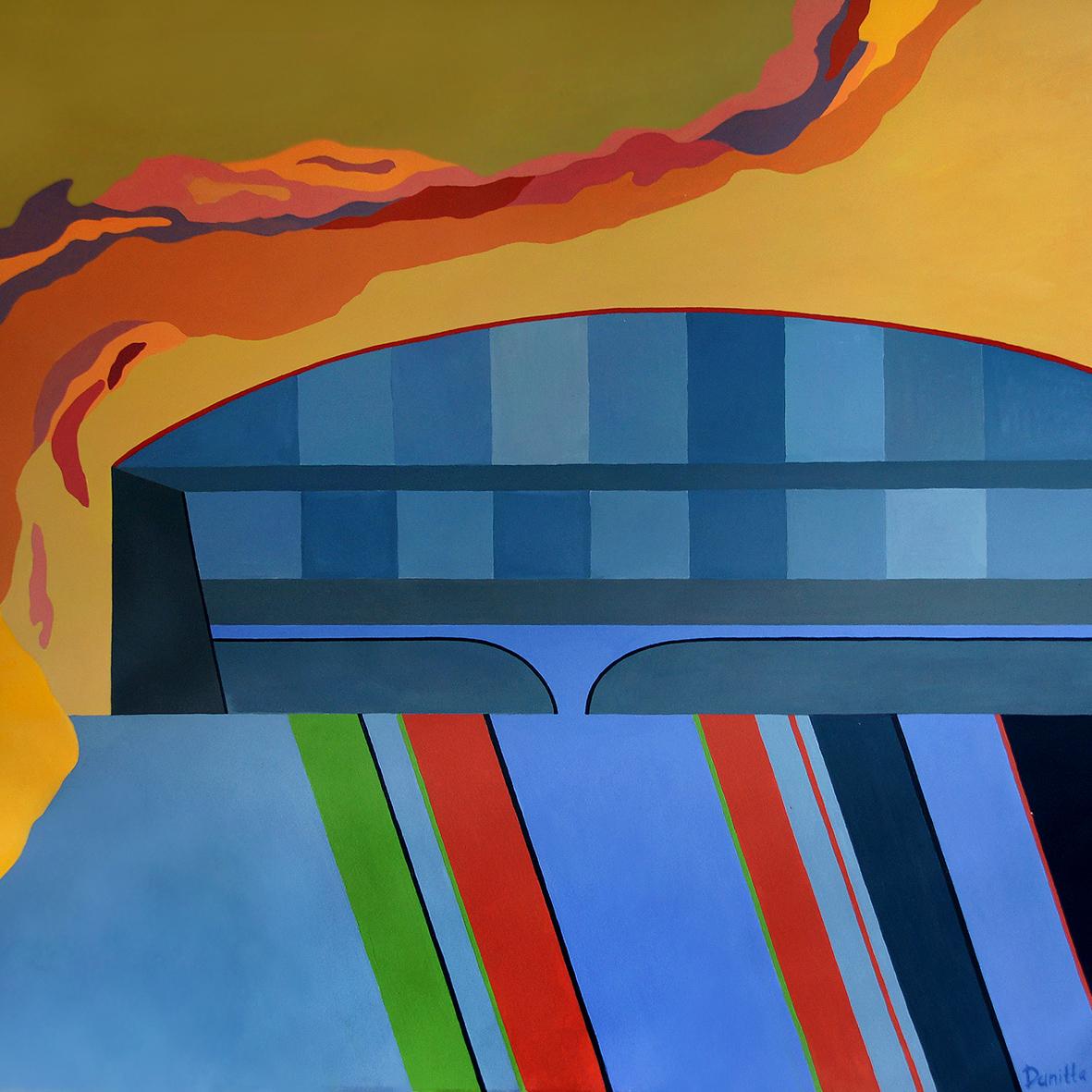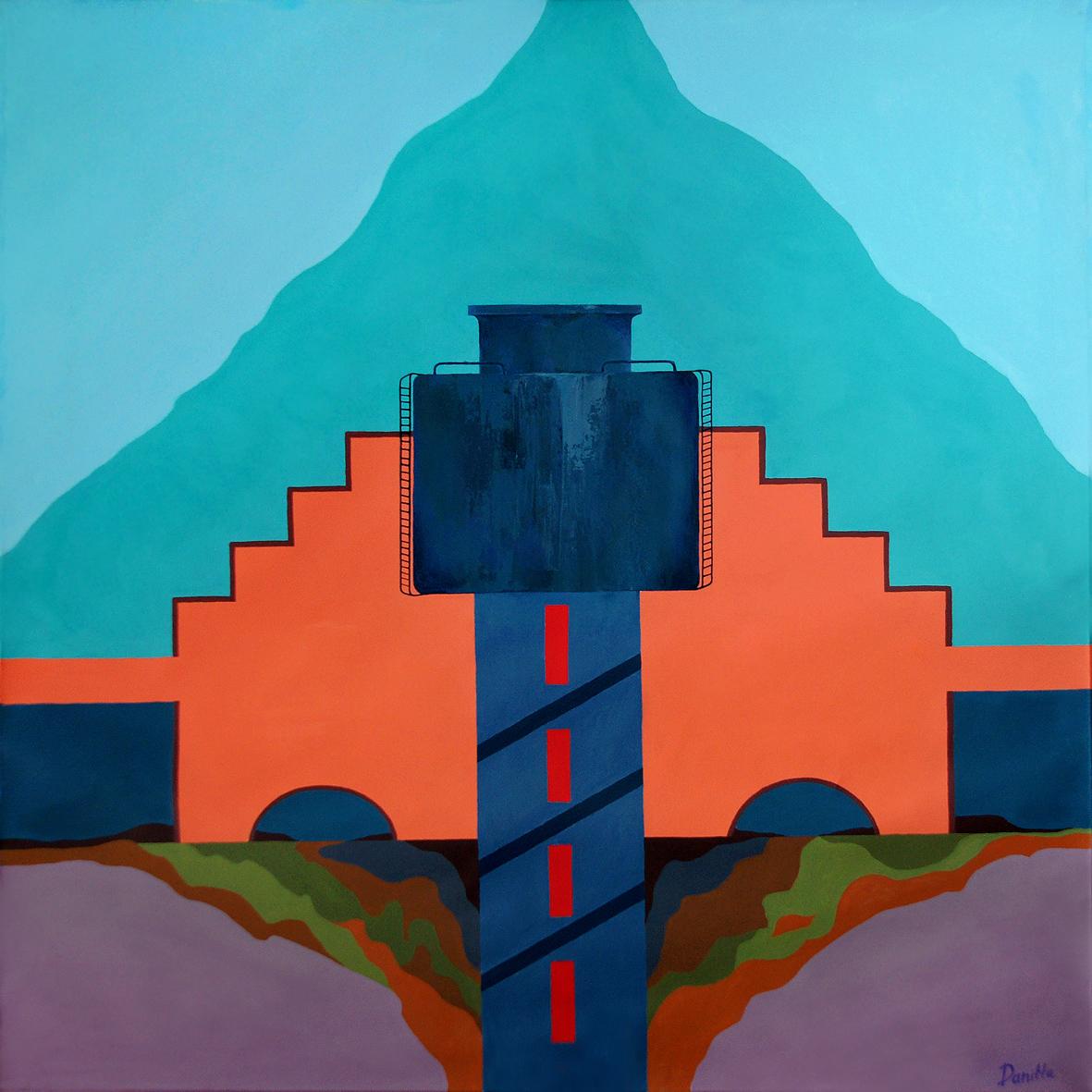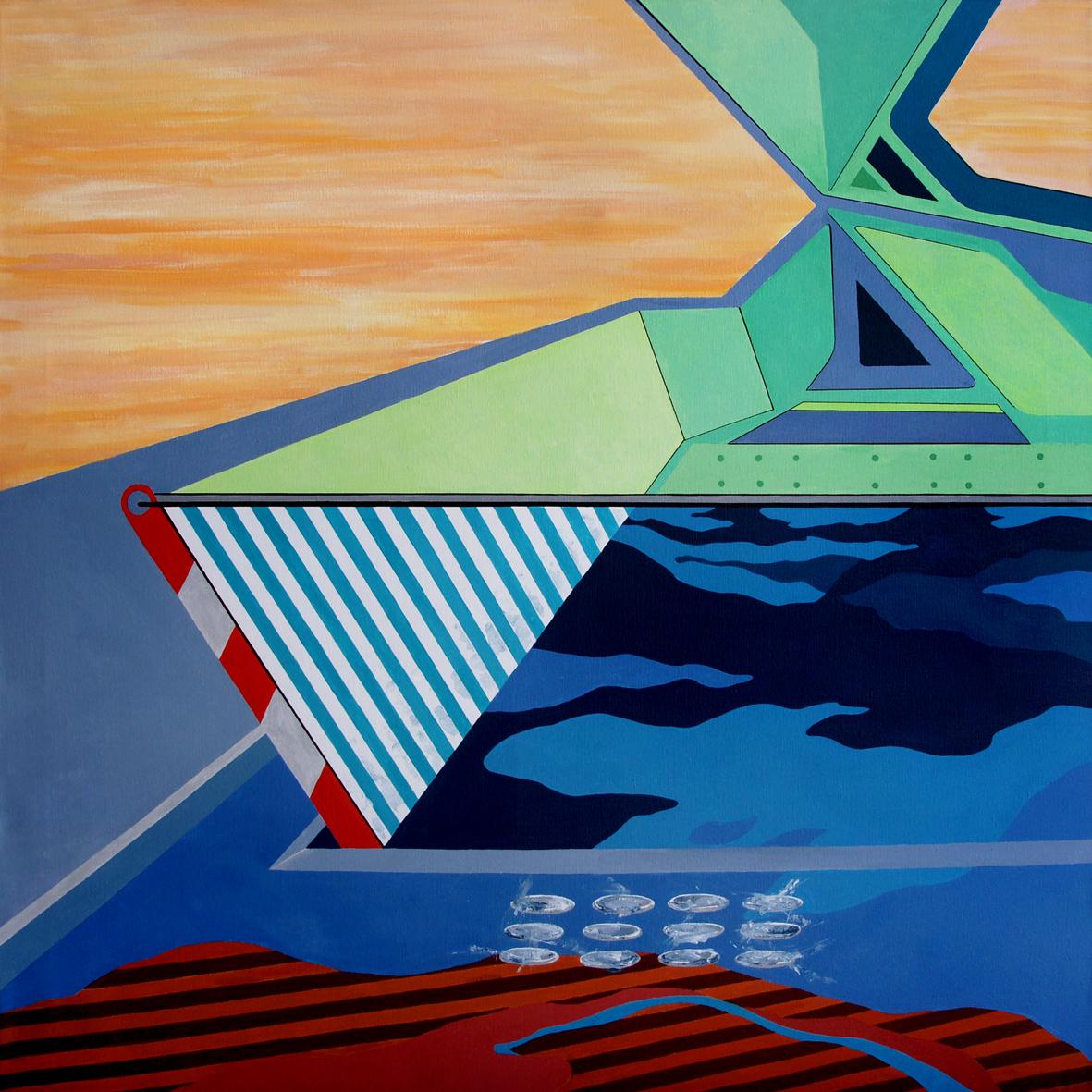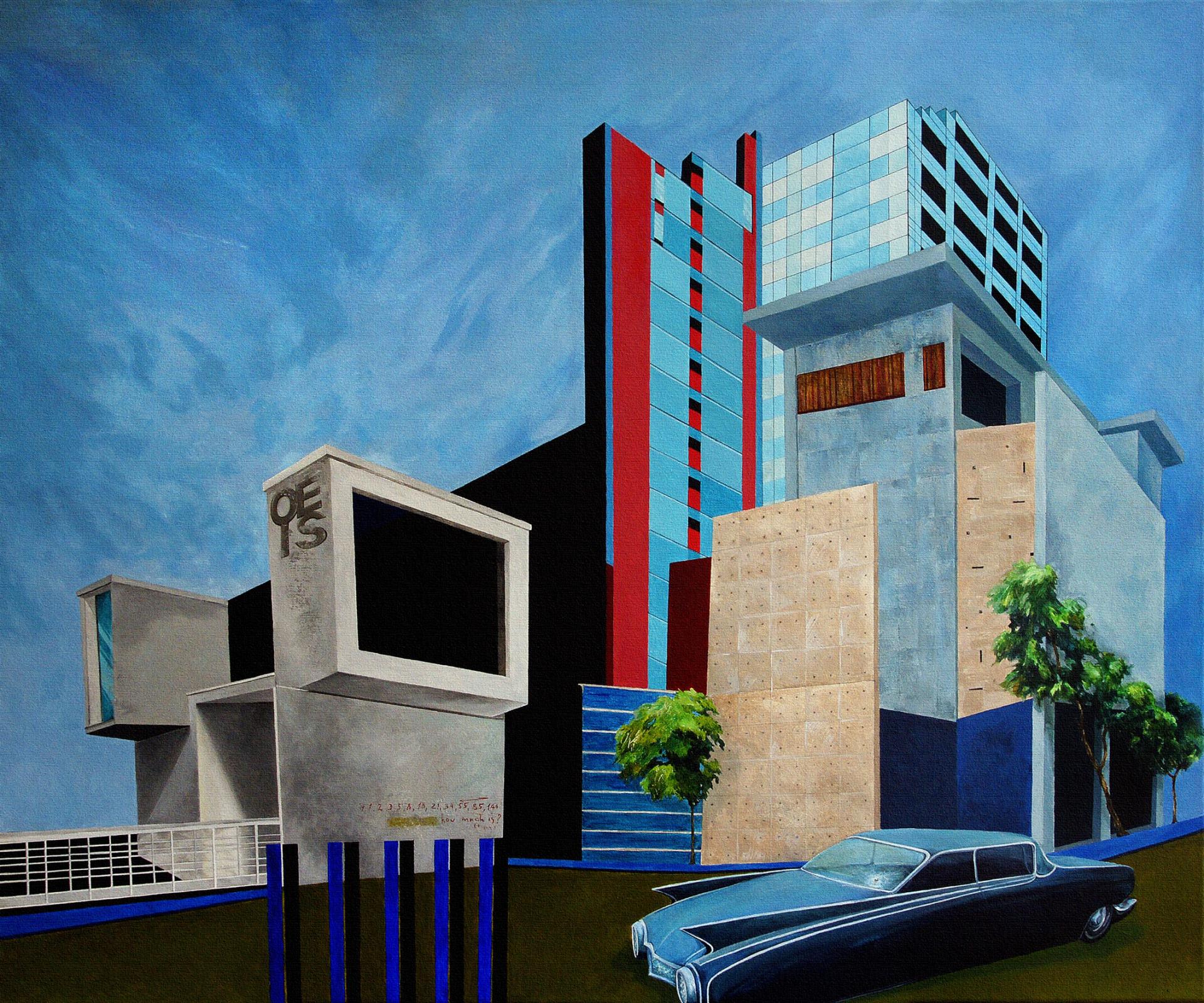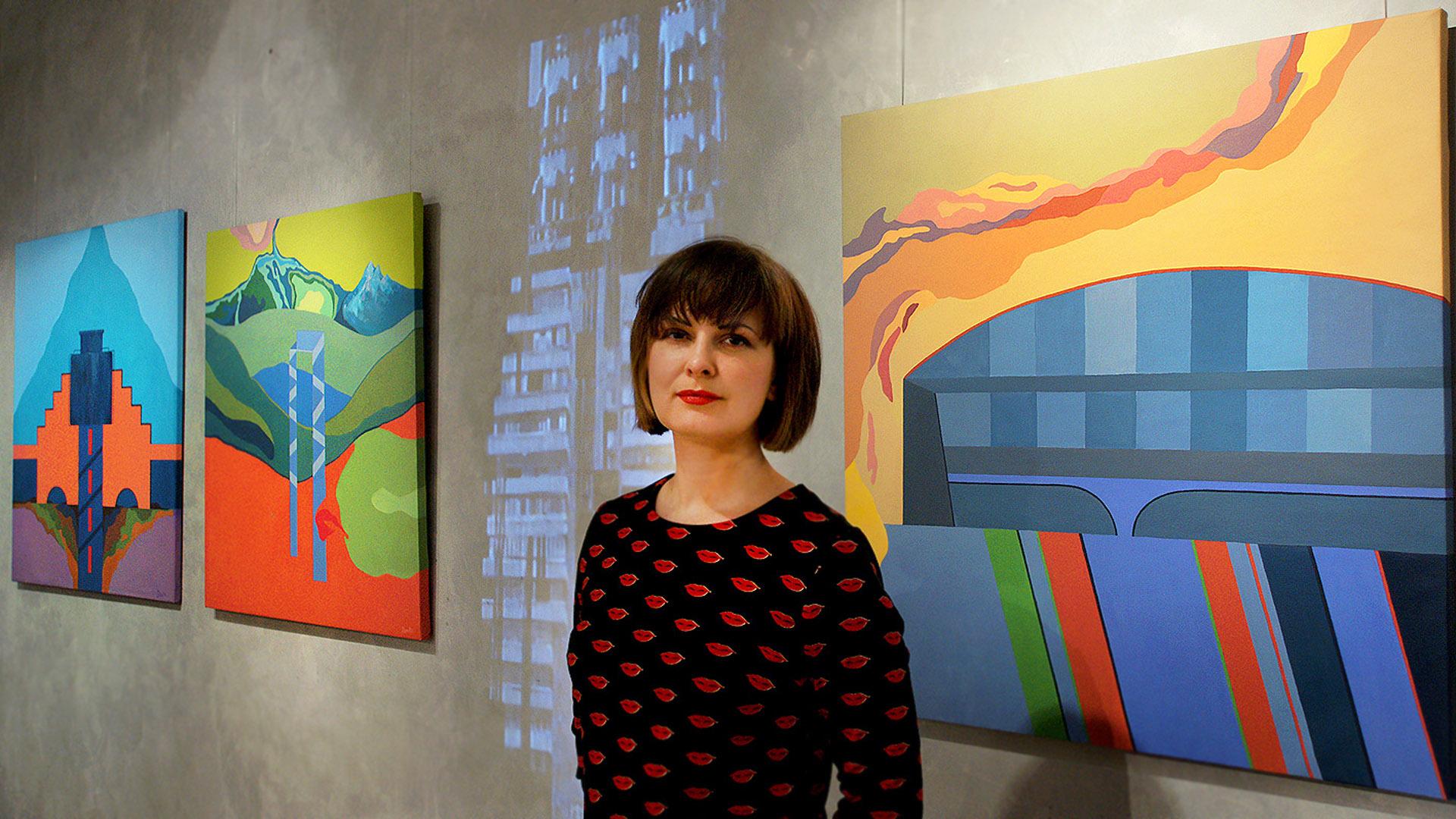Episodes of Oecumene 2015 - 2023
20.12.2022
The desolated post-industrial landscapes of Danitta Push based on the tradition in European and American art of the early 20th century, which was caused by the euphoria of an industrial boom and a significant transformation of a natural landscape as a result of its active use. Danitta's «Oecumene» does not contain the post-industrial depressions of her predecessors, since the pictures painted with acrylics, vivid oneiric images of her engineering landscapes, it seems, and they absorbed sci-fi illustrations of the 60-70s, in which the "future" appears in a positive way.
Episodes of Oеcumene # 1, 2015 (acrylic on canvas, 90x90 cm)
Episodes of Oеcumene # 2, 2015 (acrylic on canvas, 90x90 cm)
Episodes of Oеcumene # 3, 2016 (acrylic on canvas, 100x100 cm)
Episodes of Oеcumene # 4, 2016 (acrylic on canvas, 100x100 cm)
Episodes of Oеcumene # 5, 2017 (acrylic on canvas, 100x100 cm)
Episodes of Oеcumene # 6, 2017 (acrylic on canvas, 100x100 cm)
Fibonacci Episode # 7, 2018 (acrylic on canvas, 120x100 cm)
Episodes of Oеcumene Military olive, 2018 (canvas, acrylic on wood, diameter 54 cm)
Episodes of Oеcumene Orange, 2018 (canvas, acrylic on wood, diameter 46 cm)
Episodes of Oеcumene Cerulean Vacuum, 2018 (canvas, acrylic on wood, diameter 38 cm)
Episodes of Oеcumene Azure, 2018 (canvas, acrylic on wood, diameter 28 cm)
Episodes of Oеcumene Tubing, 2018 (canvas, acrylic on wood, diameter 22 cm)
Episode Bridge architectural I, 2018 (canvas, acrylic on wood, diameter 42 cm)
Episode Bridge architectural II, 2018 (canvas, acrylic on wood, diameter 42 cm)
Episode Transportation Monument I, II, III, 2019 (canvas, acrylic on wood, triptych)
At first glance, it seems that the desolated post-industrial landscapes of Danitta Push based on the tradition in European and American art of the early 20th century; it was caused by the euphoria of an industrial boom and a significant transformation of a natural landscape as a result of its active use. The painters Charles Demuth, Charles Sheeler and later photographers Bernd and Hilla Becher created a whole dictionary of "typologies" of industrial objects, actively invading nature, but often already abandoned and forgotten. However, Danitta Push's «Oecumene» does not contain the post-industrial depressions of her predecessors, since the pictures painted with acrylics, vivid oneiric images of her engineering landscapes, it seems, and they absorbed sci-fi illustrations of the 60-70s, in which the "future" appears in a positive way. Incidentally, the pathos of the 60s evaporated long ago. What was once thought of as unbridled progress and innovation has long been part of the ordinary melancholic landscape, in which ancient «techne» (craftsmanship) is projected into the modern understanding of technology as an art and human ability to create, changing the world around us.
Attempts to represent and describe the future are defined collectively by the term "futurology." It is symptomatic that the German scientist Ossip Kurt Flechtheim coined the term in 1943 at the height of the world war. He argued that even if systematic forecasting did not reveal something important and unavoidable, such an opportunity would still be of crucial importance. In the 1960s, in the wake of the "space-age" euphoria, futurology was interpreted as a "science of the future" and even the creation of special institutions that developed scientific, technical and socio-economic forecasts. The prevailing hope of the future at that time was scientific-and-technological advance. It was assumed that the rapidly developing technology and robotics would quickly relieve humanity from economic and social problems. By the early 1970s, such an approach was recognized as scientifically untenable, and a new interpretation of futurology appeared as a social method. In subsequent (consecutive) years, discussions focused on modeling the prospects for the development of human civilization, on the "limits of growth" of manufacturability, on the concept of the information society, ecological pessimism and on scientific and technical optimism. The role of the futurologist, therefore, began to boil down to presenting a number of effective combinations that are consistent with priority goals, or possible scenarios for the development of society. Moreover, these predictions began to concern no longer spectacularly iridescent or terrifyingly postapocalyptic images of the future, but rather the constant criticism and destruction of our expectations and stereotypes.
Obvious connections can be traced between futurologists and authors of science fiction books, and some writers even spoke with futurological articles. The great Stanisław Lem wrote a critical study "The amount of technology" about the predictions that have been made (are made) in his own works. A certain irony about the separation of exact science and mysticism lies in the title of this book (echoing Thomas Aquinas' Summa Theology). Because the prediction procedure itself is obviously reminiscent of fortune telling. However, a person really wants to calculate all the components and build some patterns on their basis. This desire is constantly traced in history: from the famous ancient Greek "Antikythera mechanism"; attempts to build mathematical logic in the conviction of the superiority of Christianity from Raymundus Lullius; formulating the laws of mathematical logic in Gottfried Leibniz; the desire to create a universal scheme of the human body in Albrecht Durer or the construction of the universal system "To the theory of color" in Goethe.
What is it possible to rely on today in forecasting the future? Maybe the theory of the inflationary universe? Wave theory? Atomic mass table of elements? Periodic table? «Pi»? Fibonacci number? An online encyclopedia of integer sequences? Office of Weights and Measures? High Court in Strasbourg? Implicit visual references to similar fundamental concepts are scattered as signs on canvases of the project «Episodes of Oecumene». For example, in one of the canvases, we consider an episode that occurred on the street of a certain megapolis of the future. The sign on the wall of the building clearly copies the logo of the real-life online-Encyclopedia of integer sequences, and the graffiti on the street refers to the Fibonacci sequence. These logical "gears" trigger the plot. The Fibonacci Bank of this future metropolis obviously stores statistics from the posthumanism era. The cybernetic brain of the bank archives the data and builds a scheme of human evolution. Evolutionary development should have led to the formation of a post-human, an evolutionary stage of the human species, whose structure and capabilities would be different from the modern ones as a result of the active use of advanced biotechnologies. The ethical system of the Fibonacci Bank has developed a law book, which recognizes the birthright to improve human capabilities in achieving physical immortality using the Fibonacci Bank software. However, the process is endless and cannot be completed in the near bright future. At the same time, despite the possible damping of progress, the social transformation of the post-human will not stop. This process will continue to think about the future among the empty streets of Oecumene.
People have always sought to see the images of the future. Therefore, the prophets and forecasters swam in the rays of glory and attention (and continue to do so, despite the progress of the scientific and technological revolution). Although, this is not surprising, since the promise of the future also forms the prerequisites for religious faith. Often creeds offer prophecies about life after death and about the end of the world. The future always had a very special place in philosophy. People need predictions about what will happen to them. Imagination allows us to "see" some plausible models. Trust them or is critical and the process itself remains a desirable and very exciting goal. (Text by Dmitry Pilikin)
Эпизоды Ойкумены
Эпизоды Ойкумены #1, 2015 (холст, акрил, 90x90 см)
Эпизоды Ойкумены #2, 2015 (холст, акрил, 90x90 см)
Эпизоды Ойкумены #3, 2016 (холст, акрил, 100x100 см)
Эпизоды Ойкумены #4, 2016 (холст, акрил, 100x100 см)
Эпизоды Ойкумены #5, 2017 (холст, акрил, 100x100 см)
Эпизоды Ойкумены #6, 2017 (холст, акрил, 100x100 см)
Эпизод Фибоначчи #7, 2018 (холст, акрил, 120x100 см)
Эпизод Ойкумены военно-оливковый, 2018 (дерево, акрил, d 54 см)
Эпизод Ойкумены оранжевый, 2018 (дерево акрил, d 46 см)
Эпизод Ойкумены небесно-вакуумный, 2018 (дерево, акрил, d 38 см)
Эпизод Ойкумены лазурный, 2018 (дерево, акрил, d 28 см)
Эпизод Ойкумены трубный, 2018 (дерево, акрил, d 22 см)
Эпизод Мост стихийный, 2018 (дерево, акрил, d 42 см)
Эпизод Мост архитектурный, 2018 (дерево акрил, d 42 см)
Episode Транспортный Монумент I, II, III, 2019 (дерево, акрил, триптих)
В проекте "Эпизоды Ойкумены" художник совмещает разные виды картографирования мира, исследуя следы демаркации границы воображаемого ландшафта. Метод хорографии продуцирует стилистику изображения участков Земли, окаймленных иллюзорными границами или природными образованиями. Живописный пейзаж — это репрезентации областей пейзажа, выхваченного зрением: взгляд зрителя, перемещаясь по поверхности ойкумена и цепляясь то за изометрические иллюзии, то геологические срезы, пытается охватить совокупность различных теорий о Земле.
На первый взгляд, кажется, что в проекте «Эпизоды Ойкумены» безлюдные постиндустриальные ландшафты Даниты Пушкаревой отталкиваются от традиции в европейском и американском искусстве начала 20 века, которая была вызвана эйфорией промышленного бума и значительным преобразованием природного ландшафта в результате активного его использования. Живописцы Чарльз Демут, Чарльз Шилер и позднее фотографы Бернд и Хилла Бехер создали целый словарь «типологий» индустриальных объектов, активно вторгающихся в природу, но часто уже заброшенных и забытых.
Однако, в «Ойкуменах» Даниты Пушкаревой нет постиндустриальной депрессии предшественников, поскольку, написанные акрилом, яркие онейрические образы ее инженерных ландшафтов, как кажется, впитали в себя также и научно-фантастические иллюстрации 60-70 х, в которых «будущее» предстает исключительно в позитивном ключе. Впрочем, пафос 60-х давно испарился и то, что некогда читалось, как безудержный прогресс и инновация давно уже стало частью обыденного меланхолического пейзажа, в котором античное techne (ремесленное мастерство) проецируется в современное понимание техники, как искусства и человеческого умения созидать, изменяя окружающий мир.
Попытки представить и описать будущее определяют собирательном термином «футурология». Довольно симптоматично, что сам термин был придуман в самый разгар мировой войны, в 1943 году немецким ученым Осипом Куртом Флехтхаймом. Он утверждал, что даже если систематическое прогнозирование не откроет нечто важное и неизбежное, сама такая возможность все равно будет иметь решающее значение. В 1960-е, на волне эйфории «космической эры» футурологию стали трактовать как «науку о будущем» и даже создавать специальные институты, которые разрабатывали научно-технические и социально-экономические прогнозы. Преобладающей надеждой будущего в то время был научно-технический прогресс. Предполагалось, что бурно развивающиеся технологии и робототехника быстро избавят человечество от экономических и социальных проблем. Однако, к началу 1970-х такой подход был признан научно несостоятельным и появилась новая трактовка футурологии как метода социального. В последующие годы дискуссии шли о моделировании перспектив развития человеческой цивилизации, о «пределах роста» технологичности, о концепции информационного общества, экологическом пессимизме и, опять, о научно-техническом оптимизме. Роль футуролога, таким образом, стала сводиться к тому, чтобы представить ряд эффективных комбинаций, согласованных с приоритетными целями, либо возможных сценариев развития общества. Причем, эти прогнозы стали касаться уже не эффектно-радужных или ужасающе-постапокалиптических образов будущего, а скорее постоянной критике и разрушении наших ожиданий и стереотипов.
Между футурологами и авторами книг научной фантастики прослеживаются очевидные связи, а некоторые писатели даже выступали с футурологическими статьями. Великий Станислав Лем написал отдельное критическое исследование «Сумма технологии» по поводу прогнозов, которые прозвучали в его собственных произведениях. Уже в заголовке этой книги, перекликающейся с «Суммой теологии» Фомы Аквинского, заложена определенная ирония по поводу водораздела, некогда разделившего точную науку и мистику. Ведь сама процедура прогнозирования очевидно напоминает гадание. Однако, человеку очень хочется просчитать все слагаемые и на их основе выстроить некие закономерности. Это желание постоянно прослеживается в истории: от знаменитого древнегреческого «антикитерского механизма»; попыток выстроить математическую логику в убеждении превосходства христианства у Раймонда Луллия; формулировании законов математической логики у Готфрида Лейбница; желании создать универсальную схему рисунка человеческого тела у Дюрера или построении универсальной системы «К теории цвета» у Гете.
На что же сегодня возможно опереться в прогнозировании будущего? На теорию инфляционной вселенной? Волновую теорию? Таблицу атомных масс элементов? Таблицу Менделеева? Число «Пи»? Число Фибоначчи? Онлайн-энциклопедию целочисленных последовательностей? Палату мер и весов? Верховный суд в Страсбурге? Не явные визуальные отсылки на подобные фундаментальные понятия разбросаны как знаки по холстам проекта «Эпизоды Ойкумены». Например, в одном из холстов мы рассматриваем эпизод, произошедший на улице некоего мегаполиса будущего. Вывеска на стене здания явно копирует лого реально существующей онлайн-энциклопедии целочисленных последовательностей, а граффити на улице отсылает к последовательности Фибоначчи. Это и есть те логические «шестеренки», которые запускают сюжет. Банк Фибоначчи этого мегаполиса, будущего очевидно хранит статистические данные эпохи постгуманизма. Кибернетический мозг банка архивирует данные и строит схемы эволюции человека.
Эволюционное развитие должно было привести к становлению постчеловека – эволюционной стадии человеческого вида, строение и возможности которой стали бы отличными от современных в результате активного использования передовых биотехнологий. Этическая система банка Фибоначчи разработала кодекс, который признаёт неотъемлемым правом совершенствование человеческих возможностей в достижении физического бессмертия с помощью программного обеспечения Банка Фибоначчи. Однако, процесс бесконечен и не может быть завершен в ближайшем светлом будущем. При этом, несмотря на возможное затухание прогресса, социальные трансформации постчеловека не остановятся. Он продолжит мыслить о будущем среди пустых улиц Ойкумены.
Люди всегда стремились увидеть образы будущего. Поэтому, пророки и предсказатели купались в лучах славы и внимания (и продолжают это делать, несмотря на прогресс научно-технической революции). Хотя, и это не удивительно, так как обещание будущего также формирует предпосылки для религиозной веры. Часто вероисповедания предлагают пророчества о жизни после смерти и также о конце мира. Будущее всегда имело очень специальное место и в философии. Люди нуждаются в предсказаниях того, что же с ними произойдёт. Воображение позволяет нам «видеть» некие правдоподобные модели – доверять им или относится критически. И сам этот процесс остается желанной и весьма увлекательной целью. (Текст Дмитрия Пиликина)

